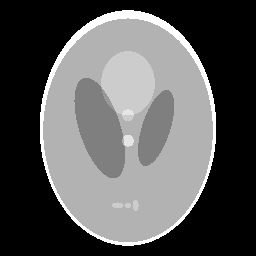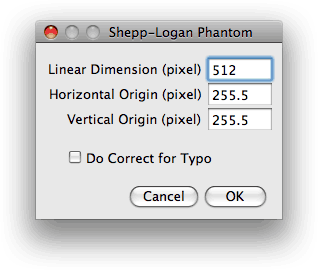| Biomedical Imaging Group |
| CONTENTS | ||||||
|---|---|---|---|---|---|---|
| Home Page | ||||||
| News & Events | ||||||
| Members | ||||||
| Publications | ||||||
| Tutorials and Reviews | ||||||
| Research | ||||||
| Demos | ||||||
| Download Algorithms | ||||||
| SheppLogan | ||||||
|
| DOWNLOAD |
|---|
| ZIP distribution |
| Source file |
SheppLogan
An ImageJ plugin for the creation of the Shepp-Logan phantom.
Philippe Thévenaz, Biomedical Imaging Group, École polytechnique fédérale de Lausanne (EPFL)

Figure 1. A (256x256) version of the original Shepp-Logan phantom. Here, for display purposes, intensity 0.95 has been mapped to 0 (black) and intensity 1.05 has been mapped to 255 (white). The plugin itself generates intensities between 0.0 and 2.0.
General Description
The purpose of this plugin is to generate sampled versions of the Shepp-Logan phantom. It is possible to specify the location of the origin (so that the figure may be made symmetric with respect to the center of a pixel or with respect to the boundary between pixels). Unfortunately, what is apparently a typo has crept into the original paper. There, Table I pp. 32 mentions that Ellipse g should have intensity 0.01, while Figure 1 pp. 34 clearly suggests that the intensity of Ellipse g should be instead 0.02, which is apparent both from the caption of Figure 1 and from the figure itself. The SheppLogan plugin can be configured to generate both versions.
I. Download
This distribution is dated September 30, 2024. It includes the complete set of source files, along with the precompiled classes.
II. Related Work
This set of Java classes is based on the following paper: L.A. Shepp, B.F. Logan, "The Fourier Reconstruction of a Head Section," IEEE Transactions on Nuclear Science, vol. 21, no. 3, pp. 21-43, June 1974.
SheppLogan has been written as a plugin for ImageJ. Please read the ImageJ documentation to learn how to install plugins.
III. User Manual

Figure 2. Dialog.
Once the plugin is fired, the dialog shown in Figure 2 appears. The plugin can be run from a macro and is recordable. The Shepp-Logan phantom is parameterized as follows:
- Linear Dimension (pixel). This gives the size of the Shepp-Logan phantom. Its shape is always a square; the given number determines the length of one side of this square, in pixel units. When the dimension is changed, a new origin is automatically computed to maintain the phantom in the center.
- Horizontal Origin (pixel). This gives the horizontal location of the center of the phantom. Low numbers shift the phantom to the left, and high numbers to the right. The meaning of 0.0 is the center of the leftmost image column; consequently, the exact geometric center of the image is 0.5 * (dimension - 1.0).
- Vertical Origin (pixel). This gives the vertical location of the center of the phantom. Low numbers shift the phantom upwards, and high numbers downwards. The meaning of 0.0 is the center of the topmost image row; consequently, the exact geometric center of the image is 0.5 * (dimension - 1.0).
- Do Correct for Typo. This switch determines the intensity of Ellipse g in the original paper from Shepp and Logan. When not ticked, this intensity is 0.01, as provided in Table 1 pp. 32 of this paper. When ticked, this intensity is 0.02, as provided in Figure 1 pp. 34 of the same paper.
IV. Conditions of Use
This program is free software: you can redistribute it and/or modify it under the terms of the GNU General Public License as published by the Free Software Foundation, either version 3 of the License, or (at your option) any later version.
This program is distributed in the hope that it will be useful, but WITHOUT ANY WARRANTY; without even the implied warranty of MERCHANTABILITY or FITNESS FOR A PARTICULAR PURPOSE. See the GNU General Public License for more details.
You should have received a copy of the GNU General Public License along with this program. If not, see https://www.gnu.org/licenses/.
EPFL makes no warranties of any kind on this software and shall in no event be liable for damages of any kind in connection with the use and exploitation of this technology.
